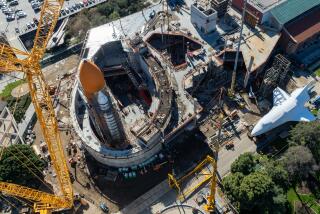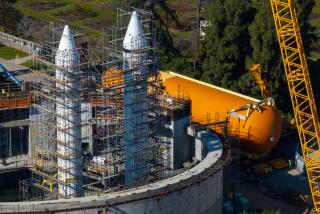Astronauts Link Russian, U.S. Space Station Parts
- Share via
JOHNSON SPACE CENTER, Texas — Endeavour’s astronauts connected the first two building blocks of the international space station Sunday, creating a seven-story tower in the shuttle cargo bay.
It was the first time that the Russian-built Zarya control module and the U.S.-made Unity chamber had ever touched. It looked to be a perfect and, hopefully, long-lasting fit.
“We have capture of Zarya,” commander Robert Cabana announced the moment the two pieces came together.
“Congratulations to the crew of the good ship Endeavour,” replied Mission Control. “That’s terrific.”
The 240-mile-high construction job began two hours earlier with Nancy Currie’s capture of Zarya (Russian for “sunrise”) using the shuttle robot arm. “We’re halfway home,” Cabana said.
Then came the hard part: stacking the two giant cylinders in the cargo bay.
The two station pieces are so big--77 feet from the tip of one to the tip of the other with a combined mass of 70,000 pounds--that Currie and her crew mates had to rely on a computerized vision system and camera views, rather than direct line of sight. This was the first time such a “blind” docking had ever been attempted.
Currie positioned the solar-winged Zarya, still on the end of the shuttle robot arm, several inches directly above Unity.
Once she was sure she had it, Cabana fired Endeavour’s thrusters, and the brief burst raised the shuttle and thereby Unity enough for the docking mechanisms on the two station components to snap together. The historical moment occurred above the South Pacific.
The union set the stage for a spacewalk by two astronauts today to attach electrical connectors and cables between the two components.
Minutes after Zarya’s capture, Cabana called down that two antennas on the module were still undeployed as Russian flight controllers had feared. The antennas must be fully deployed in order for Zarya’s manual docking system to work.
More to Read
Sign up for Essential California
The most important California stories and recommendations in your inbox every morning.
You may occasionally receive promotional content from the Los Angeles Times.










